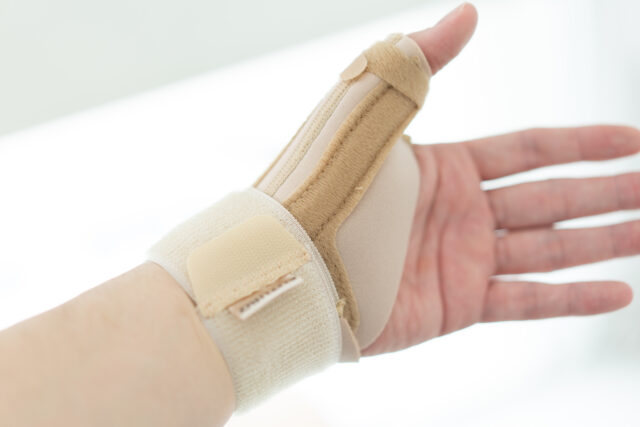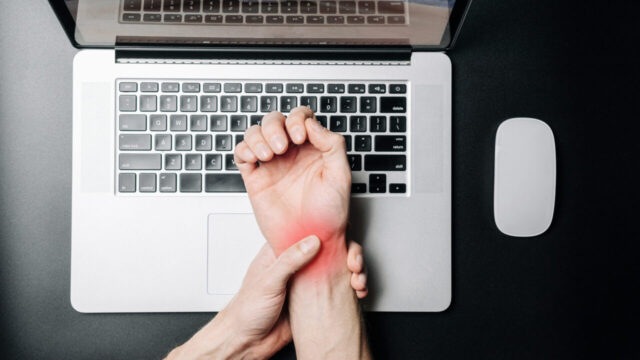There are some things you can plan for in life, and there are some things that may catch you by surprise. A wrist injury is never something planned; however, it is common. In fact, up to one in five adults will experience sharp pain in their wrist at some point in their lives.
Imagine you were playing pickleball with friends or enjoying a getaway ski weekend, and the next day, you woke up with a sore wrist. You might be left wondering what you did to injure it and how you can make the pain subside to get back to your normal routine.
Your Wrist Pain Could Be Something Bigger
Sharp pain in the wrist can signify several issues, ranging from a minor sprain to a more serious fracture. So, sudden wrist pain shouldn’t be ignored. Early diagnosis and treatment can greatly impact your recovery and future wrist health.
Here’s why: let’s say you fell, and the result is a fracture. Left untreated, that fracture would immediately impede your function, and in the long term, it could heal improperly, leading to pain and decreased mobility for years to come.
Similarly, tendonitis – inflammation of the tendons around the wrist – is typically an overuse injury; it can worsen with continued use and eventually require more aggressive therapy. Even carpal tunnel syndrome, a condition caused by pinched nerves in the wrist, can lead to permanent nerve damage and weakness in hand muscles if not addressed.
What Is the Difference Between Acute and Chronic Pain
The origin of your wrist pain can also provide clues about its severity. Acute injuries, often caused by falls, accidents, or forceful impacts, tend to come on suddenly and be accompanied by swelling, bruising, or difficulty moving your wrist.
Chronic pain, on the other hand, usually develops gradually over time due to repetitive motions or underlying conditions like arthritis. This type of pain might be dull, achy, and worsen with certain activities.
Understanding the difference between acute and chronic pain is critical to proper treatment. While rest and icing might be enough for a minor sprain, a fracture could require a cast or splint.
Hand and Occupational Therapy, ergonomic adjustments, or medication can help with chronic conditions. So, the next time a jolt of wrist pain surprises, don’t dismiss it.
Understanding Sudden Sharp Wrist Pain
Before diving into the reasons behind your wrist pain, let’s look at the key players in your wrist joint. Understanding the anatomy can help us connect the dots between structure and potential causes of pain.
Anatomy of the Wrist
The wrist joint is a complex network of bones, tendons, and ligaments that work together to provide your hand with remarkable flexibility and dexterity. Here are the main structures you should know:
Bones
Two forearm bones (radius and ulna) meet at the wrist. The radius is located on the thumb side of your hand, while the ulna is on the pinky side. Eight small carpal bones are arranged in two rows within the wrist, allowing for a wide range of motion.
These carpal bones shift and glide against each other, enabling you to flex and extend your wrist and move it side-to-side, like when you wave or twist to open a doorknob.
Tendon
These are tough, flexible tissues that connect muscle to bone. In the wrist, tendons allow muscles in your forearm to move your fingers and hand.
Ligaments
These strong bands of tissue connect bones to each other and stabilize the wrist joint.
Types of Wrist Pain
SportsMed Certified Hand Therapist, Rebecca Lieberman, OTR/L, CHT explains: “Pain can be described in many different ways, including by type of sensation, severity of sensation, and length of onset.” Different types of pain can offer clues about the underlying cause.
Here’s a breakdown of some common pain sensations and what they might indicate:
- Sharp pain: This can be a sign of a sudden injury, like a sprain, tendon tear, or even a fracture.
- Dull ache: This type of pain often suggests overuse or chronic conditions like arthritis. It might worsen with certain activities or be present at rest.
- Throbbing pain: This throbbing sensation can be associated with inflammation, perhaps due to tendonitis or bursitis (inflammation of a fluid-filled sac near a joint).
- Numbness and tingling: These can be caused by nerve compression, which may be a symptom of carpal tunnel syndrome.
- Swelling: This is a common sign of inflammation caused by injury or overuse.
The Location of the Pain Is Important
The location of your pain can also be used for diagnosis. Pain on the thumb side of your wrist might suggest problems with the tendons that control thumb movement.
Pain on the back of your wrist could be due to extensor tendons or ligaments. On the other hand, pain on the palm side might indicate issues with flexor tendons or carpal tunnel syndrome.
By paying attention to the type, location, and accompanying symptoms like swelling or weakness, you can provide your therapist with valuable information to help them diagnose the cause of your sudden sharp wrist pain and get you on the road to recovery.
Common Causes of Sudden Sharp Wrist Pain
Sudden sharp wrist pain can arise from various causes. Let’s explore some common causes:
Injuries
These are often the result of a specific event and can cause immediate pain.
- Falls and accidents: Taking a tumble or experiencing a blow to your wrist can damage bones, tendons, or ligaments, leading to sharp pain and potentially swelling or bruising. An injury caused by falling on an outstretched arm (also called a FOOSH injury) and car accidents (due to airbag impact) are common culprits of wrist fractures.
- Sports injuries: Activities like gymnastics, weightlifting, or sports with racquets can stress your wrist, causing sprains, strains, or even fractures.
- Sprains and strains: Overstretching or tearing of ligaments or tendons can cause sharp pain, tenderness, and difficulty moving your wrist.
- Fractures: A broken bone in your wrist will likely cause significant pain, swelling, and deformity.
Overuse Injuries
These develop gradually due to repetitive motions that strain the wrist.
- Tendinitis: Inflammation of the tendons around the wrist can cause sharp pain, especially with certain movements. This is common among manual laborers and individuals who engage in repetitive tasks. Tendinitis is also common with sports overuse injuries.
- Carpal tunnel syndrome: This condition arises from compression of the median nerve in the wrist, leading to pain, numbness, and tingling in the thumb, index, middle, and half of the ring finger. SportsMed Certified Hand Therapist Rebecca Lieberman, OTR/L, CHT shares: “We see more compression of the median nerve (aka ‘Carpal Tunnel Syndrome’) in patients who have to sustain grasp on items for long lengths of time, as well as people who work long hours on the computer.”
- De Quervain’s tenosynovitis: Nicknamed “mommy thumb,” this condition involves inflammation of the tendons around the base of the thumb. It’s often associated with activities that require repetitive gripping, like supporting a baby’s head while feeding them. This pain typically radiates down the thumb side of the forearm.
Other Causes
- Arthritis: Degenerative joint diseases like osteoarthritis can cause pain, stiffness, and swelling in the wrist.
- Ganglion cysts: These are fluid-filled sacs that can develop on the back of the wrist and cause pain or discomfort.
- Nerve impingement: Compression of a nerve in the wrist, besides carpal tunnel syndrome, can also lead to sharp pain, numbness, and tingling.
Treatment Options for Sudden Sharp Wrist Pain
Sudden sharp wrist pain can be disruptive to your normal routine, but the good news is there are treatment options to get you back on track.
Here’s an overview of some common approaches:
The RICE Method
The RICE method can be a helpful first step in managing initial pain and inflammation after an injury to the wrist:
- Rest: Give your wrist a break from activities that aggravate the pain.
- Ice: Apply ice packs wrapped in a towel for 15-20 minutes at a time, several times daily, to reduce swelling.
- Compression: A gentle compression wrap can minimize swelling and provide support.
- Elevation: Keep your wrist above your heart whenever possible to reduce inflammation.
Over-the-counter Pain Medication
Medications like ibuprofen or acetaminophen can help manage pain and inflammation.
Splinting or Bracing
Sometimes, your doctor might recommend wearing a wrist splint or brace to immobilize your wrist and promote healing. This can be helpful for sprains, strains, or fractures.

Occupational or Physical Therapy
You can see an Occupational Therapist or a Physical Therapist for comprehensive treatment.
At SportsMed, we have a team of Occupational Therapists and Certified Hand Therapists who specialize in upper extremity injuries and treatments.
These experts can design a personalized program to address your specific needs. Here’s what you can expect:
As Rebecca Lieberman, OTR/L and Certified Hand Therapist at SportsMed, says, “Our goal is to help you get back to your normal routine and preferred activities. We will work together to come up with a treatment plan that works best for you, and create an individualized program to target your personal goals and get you back to doing what you love.”
Through occupational therapy, you’ll learn exercises to improve your wrist’s flexibility, strength, and range of motion. They can also guide modifying daily activities to prevent further strain.
When to See a Doctor
While you can manage some wrist pain with home care, there are situations where seeking medical attention is crucial.
Here are some red flags that warrant a doctor’s visit:
- Severe pain that doesn’t improve with rest
- Significant swelling or bruising
- Deformity of the wrist
- Limited range of motion and movement in your wrist
- Reduction in strength
Keeping tabs on when your wrist discomfort occurs can be very helpful. Does it happen while using a knife for meal preparation, holding the steering wheel, using the computer mouse, weightlifting, or pushing yourself up from a chair?
This information will help your therapist pinpoint the source of the pain and recommend the most appropriate treatment course.
How to Prevent Sudden Sharp Wrist Pain
Here are some easy tips to prevent sudden sharp wrist pain:
Ergonomics
Many activities, from typing to playing tennis, can strain your wrists. Here’s how proper posture and techniques can help:
General Posture
- Neutral Wrist Position: This is key. Your wrists should be straight, not bent up or down, while you’re performing the activity.
- Elbow Height: Keep your elbows below shoulder level for most activities. This reduces tension in your forearms and wrists.
- Supported Spine: Maintain good posture with your back straight and supported by a chair with good lumbar support.
Specific Techniques
Typing: Adjust your chair and desk height so your wrists stay neutral while typing. Relax your shoulders and keep your fingers loose while hovering over the keys. Take frequent breaks to stretch your hands and wrists.
Using a Mouse: Choose a mouse that fits your hand comfortably. Avoid gripping it too tightly. Be careful with “wrist rests” as they may look supportive, but can also compress the median nerve.

Gaming: Like a mouse, choose a controller that fits your hand size. Take breaks to stretch and avoid gripping the controller excessively during intense moments.
Lifting: When lifting objects, engage your core and legs. Keep your wrists straight, and avoid bending them while lifting.
Strengthening Exercises
Here are some exercises to improve wrist strength and stability:
Wrist Flexion and Extension
This exercise strengthens the muscles that bend your wrist upwards (flexion) and downwards (extension).
- Sit with your forearm on a table or pillow.
- Hold a light dumbbell (1-3 lbs) with your palm facing down.
- Bend your wrist to aise the weight as high as possible; your palm will face forward.
- Squeeze your forearm muscles on top.
- Slowly lower the weight back to the starting position.
- Repeat 10-15 times.
- Flip your hand over so your palm faces up, and repeat steps 3-5.
Wrist Pronation and Supination
This exercise strengthens the muscles that rotate your forearm.
- Sit with your forearm on a table and elbow bent.
- Hold a light dumbbell with your thumb pointing towards the ceiling (neutral position).
- Rotate your wrist so your palm faces down towards the table (pronation).
- Squeeze and hold for a second.
- Then rotate your wrist back up so your palm faces the ceiling (supination).
- Repeat 10-15 times in each direction.
Passive Wrist Stretches
These stretches help improve flexibility and range of motion in your wrist.
Wrist Flexor Stretch
- Extend your arm out in front of you with your palm facing down.
- Use your other hand to gently push down on the back of your hand, directing your fingers down and feeling the stretch at the top of your wrist.
- Hold for 15-30 seconds.
Wrist Extensor Stretch
- Extend your arm out in front of you with your palm facing up.
- Use your other hand to gently put pressure downward on the palm of your hand, stretching the underside of your wrist. Be mindful to put pressure on your palm and not your fingers to focus on the wrist.
- Hold for 15-30 seconds.
Taking Breaks
Taking breaks during repetitive tasks is crucial to prevent wrist strain and fatigue.
Take a short break every 15-20 minutes to stretch your wrists and hands. Avoid gripping objects too tightly. Alternate tasks that require hand and wrist strength with tasks that don’t.
By incorporating these exercises and stretches into your routine, you can improve your wrist strength, stability, and prevent future injuries. Remember to start slow, listen to your body, and gradually increase the difficulty as you get stronger.
Can I sleep on my wrist pain?
Sleeping on your wrist when in pain can worsen it. While elevating it on a pillow might offer temporary relief, consider these options too:
- Wrap for support: An ace bandage can provide support, but ensure it’s not too tight to avoid restricting blood flow (tingling fingers).
- See a medical professional: This is the best course for proper diagnosis and treatment.
Wrapping Up
Sudden sharp wrist pain can be caused by various factors, including overuse, injuries, or underlying conditions.
For personalized guidance, especially for persistent pain, consult an Occupational Therapist specializing in hands and upper extremities at SportsMed Physical Therapy. They can diagnose properly and create a treatment plan to get you back to using your wrist comfortably. Schedule a consultation today.



